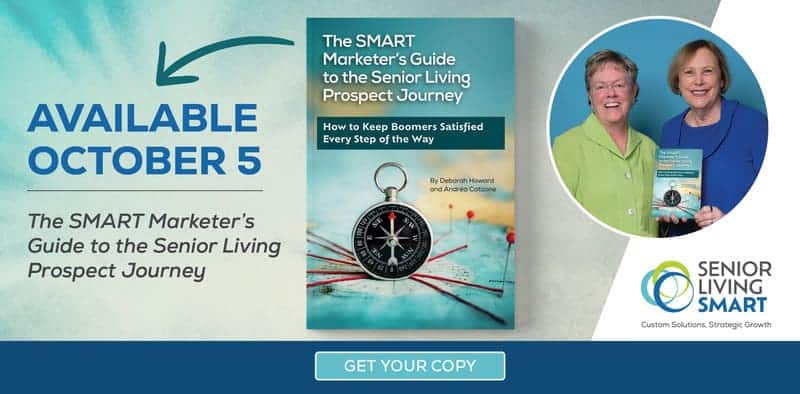9 Buyer Persona Questions for Your Best Residents

Editor’s note: This article was revised and updated in September 2025.
If you’re not spending time talking to your best residents, you’re missing out on valuable marketing and sales intelligence.
Your community’s happiest residents can:
- Serve as a living and breathing example of your ideal prospect
- Share thoughts about your competitors
- Indicate which messages resonated with them and which ones fell flat
This doesn’t need to be a formal sit-down. Have a casual conversation. Write up your notes afterward. Once you have critical mass (meaning notes from five or more conversations with some of your best residents), revisit your existing personas and refine your messaging and engagement strategies to best market to your intended audience.
Below, we dive deeper into these tasks, starting with what a buyer persona is and nine buyer persona questions we recommend asking your best residents.
Let’s get to it.
What is a buyer persona?
Buyer personas are semi-fictional profiles that represent your ideal residents and the family members who influence their decisions. These profiles help you understand your audience on a deeper level so you can communicate more effectively.
Instead of blasting the same message to every lead, you can segment your audience by persona and deliver personalized content that speaks directly to their needs and concerns.
Remember, buyer personas are internal tools meant to guide your sales and marketing strategies—not something you share with prospects.
Now, let’s move onto the persona questions you should ask your best residents.
1. What was your biggest concern or fear about our community before you chose it? What helped you overcome these concerns?
Why ask this question? It’s helpful to understand people’s objections about your community and how they overcame them.
- Was it something your marketing or sales team did to help address their concerns? If yes, you’ll want to know so you can continue doing it.
- Or did they somehow convince themselves? In this case, you can focus on having your marketing and sales team better address specific concerns, especially if you note a common theme among the residents you chat with.
Keep in mind that objections can change over time, and they will change from demo to demo. The objections that folks from the Greatest Generation had five years ago likely won’t be the same as the objections boomers have.
Asking this question can also help challenge your own assumptions. For example, one of our clients with an older community worried it would be impossible to compete with the glitzy and glamorous new community down the road.
But once we began talking to the happiest residents, we learned they were turned off by the new place’s glitz and glamour and preferred a more homey and comfortable setting. This intel fueled our marketing and paid ad initiatives so we could attract more people like our happiest residents.
2. What would you tell someone else considering a move to our community about your move-in experience?
Why ask this question? Here’s where you can uncover important gaps, especially between the marketing and sales handoff. Do the residents talk about any issues after they made their deposit? Are they neutral about it? Or did they have a seamless experience from first interaction to move-in (and beyond)? If yes to the latter, what was so great about the experience?
Bottom line: You want to do more of what’s working and fix what isn’t.
3. What specific amenities or services made the biggest difference in your decision?
Why ask this question? Marketing and sales teams are often too close to the product they’re selling. What sounds exciting to your team might not matter much to the resident.
But there’s another reason to ask this question: Hearing how real residents discuss various services and amenities can help with messaging.
For example, many communities have an on-site hair salon, but only your community has a stylist named Liz with a penchant for color and pin-curls. You get the idea. Having those conversations with residents will surface compelling words and phrases that you can sprinkle throughout your marketing for added authenticity.
4. How did you first hear about our community, and what resources did you use to research us?
Why ask this question? You might think you’re covered if your marketing automation and CRM are integrated properly. Don’t get us wrong: You want your martech platform connected bilaterally to your senior living CRM so you can see when, where, and how a lead first enters your site and their conversion touch points along the way.
But how do you track the conversation that happened at a cookout two summers ago where your now-happy resident first learned about your community from an old friend—and that friend’s testimonial made your resident aware of your senior living brand in the first place?
Asking this question can help you better gauge how much brand awareness residents had before they began their search and how well your brand-building initiatives have and haven’t been working.
5. What was the most frustrating part of the senior living search process?
Why ask this question? Residents might not have any frustrations with your community specifically—and if so, great. But listen closely for broader complaints like, “Everywhere we looked did this,” or “No one ever did that.” These comments can shine a light on common pain points in the senior living search. If your community can avoid or solve these issues, you’ll stand out.
Note: Some frustrations may fall outside of sales and marketing’s control. If that’s the case, pass along the feedback to the right team, whether that’s operations, dining, or activities.
6. What did other communities do better than us, and what ultimately convinced you our community was the right fit?
Why ask this question? Understanding the final “tipping point” for residents can offer invaluable insights into what truly resonates with prospects during their decision-making process.
Whether it’s specific amenities, the level of care, or the community’s atmosphere, identifying these factors can ensure you promote them to like-minded prospects (think look-alike audiences).
- PRO TIP: Knowing what intrigued people about your competitors is also valuable intel. For example, maybe your best residents mentioned a feature about your competitors that they didn’t realize is also available in your community. That suggests you need to better highlight this feature on your site, social media channels, and during tours.
7. What’s something you wish you knew before moving in that would’ve made the transition easier?
Why ask this question? Too often, marketing thinks their job is done once they hand off a sales-qualified lead (SQL) to the sales team. And too often, the sales team thinks their job is done once an SQL makes a deposit. But what about that precious time between deposit and move-in? And those critical 30 days after move-in?
We’re not trying to make more work for people, but the reality is that there’s a gap that needs closing. If you make a person’s move-in experience seamless and their first month as wonderful as possible, you’re positioning the resident for ultimate success in your community, which can lead to fabulous five-star reviews and excellent referrals.
The good news? This gap doesn’t require a heavy lift. Just as marketing automation helps nurture not-ready-yet leads to sales-qualified status, marketing automation can help guide soon-to-be-new residents through the transition with a friendly welcome letter, helpful resources (such as local movers), and the like.
- PRO TIP: We’ve created a turnkey program called “Countdown to Move-in Day” that our clients can customize.
8. How has living here impacted your daily routine or quality of life compared to your previous living situation?
Why ask this question? This question gives you a direct window into how your community has improved residents’ lives. Identifying the tangible benefits of living in your community is crucial, such as increased socialization, improved wellness, or a better sense of security.
You can then leverage these real-life benefits to create more compelling, value-driven messaging and stories that align with the prospect’s ultimate goal: enhancing their lifestyle. By focusing on the positive transformations, you’re showing prospects what they have to gain by moving in.
9. How do you define “feeling at home” in a community, and what aspects of our community helped create that feeling?
Why ask this question? A sense of home is deeply personal and often subjective, but it’s also a powerful driver in senior living decisions. Asking this question helps you pinpoint the specific elements—whether it’s staff interactions, social opportunities, or even the physical environment—that make residents feel truly at home.
These insights allow your marketing team to highlight those emotional and environmental aspects in your campaigns, making your messaging resonate more deeply with prospects searching for a comfortable and welcoming community.
How to use the insights that you gather from these conversations
Once you’ve gathered responses to these questions, revisiting and refining your buyer personas is essential. Use the insights to update key persona traits, such as motivations, pain points, and decision-making triggers. From there, adjust messaging and other engagement strategies accordingly.
For example, if many residents cite specific amenities or a strong sense of community as top reasons for choosing your community, your marketing should emphasize those elements more.
Additionally, note any behavior shifts, such as the increased use of a particular digital channel, and rethink how you’re using that channel. For example, if you’re finding that your happiest residents are big Instagram users, you might want to look into how you can leverage the platform more, whether encouraging user-generated content to promote your brand or experimenting with paid ads.
By updating your marketing personas with honest resident feedback and the messaging you use to engage them, your marketing will align better with your target audience’s evolving preferences and expectations.
Need help perfecting your personas and messaging?
We understand the customer journey in senior living and can help you fine-tune your personas and messaging. Get in touch, and let’s chat.






























